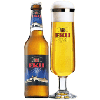EKU Brauerei - EKU Pils
-
ABV:
5.00% -
Serving Temperature:
48° F
EKU Pils is, as you may have guessed, a Pilsner, which since its inception as a style of beer in 1842 has become the single most popular style of beer the world has ever known. Golden in color, it originated in the Czech Republic town of Pilsen. Up until that time, all beer was dark and cloudy. The Czech pilsner was the first beer to be brewed clear and golden. The Germans quickly proved to be the most passionate devotees of the new style and the name of the style was soon shortened to "Pils." The German contribution was to make the beer a bit lighter in body—better suited to everyday drinking—and to add an extra dose of hops for a refreshingly bitter zing. Expect a massive, brilliant white head to top this lucent gold, well-carbonated beer. Look for a characteristic pilsner maltiness with notes of floral and spicy hops. We found it to be remarkably refreshing, easy-drinking, with a crisp, clean, dry finish and slightly bitter hop-driven aftertaste. A very food-friendly beer that will partner nicely with anything from light fish to Chicken Kiev to pizza to spicy Thai cuisine.
So you may have noticed—if you were a member of the club in February—that we have selected another beer from the Northern Bavarian town of Kulmbach, Germany. The fact is there are so many amazing beers from this town that we could literally spend an entire year featuring brews from this region of exceptional brewing prowess. The town is known for a variety of beer styles, but the most notable is indigenous to Kulmbach: "eisbock". This unique style of beer is based on a variant of the traditional bock style initially made famous in the town of Einbeck, Germany, located about 175 miles northwest of Kulmbach. Einbeck's unique beer was not originally known as "bock" beer. Through years of Bavarians requesting "Einbeck Bier" the name became corrupted to "Ein Bock Bier" (sounding like "one bock beer" in German), and ultimately just "Bock Bier".
The "doppelbock" is a variation of bock beer that rose to popularity after the creation of the original doppelbock, Salvator. According to local lore, a wooden barrel of doppelbock bier (in the 6.5-7.5% ABV range) was accidentally abandoned in the yard of a Kulmbach brewery in the dead of winter. Snowfall covered the barrel and it was forgotten until uncovered by thawing in early spring. By the time it was found, the contents were partially frozen, and the barrel had split open enough to expel some of the original contents, but leaving behind a fair amount of the original brew. The ice that encased it was chipped away, and the residual beer left inside was tasted (crazy brewery staff—they'll drink anything), whereupon it was discovered to be much richer and more concentrated than the original. The reason behind this phenomenal discovery is a matter of simple physics; water freezes before alcohol, thus, some of the beer's water content was forced out of the brew and froze, eventually being removed as it was chipped away when they discovered it. The contents remaining inside therefore underwent a relative increase in the proportion of alcohol to the remaining beer volume. This "technique" was refined, and today gives us one of the beers the region is famous for: Eisbock (eis means ice in German). Here we have the union of physics and beer history—what an educational newsletter this month, huh?
The Kulmbach beer we featured back in February is the original Bavarian Eisbock, known simply as Kulmbacher Eisbock and brewed by the Kulmbacher Brauerei. A similar beer is EKU 28, brewed by the Kulmbacher Brewery's long time nemesis, the EKU Brauerei (also located in Kulmbach). EKU stands for Erste Kulmbacher Union, which translates to "First United Brewery" (read the review of EKU 28 below if you want to know where the "28" comes from). It was founded in 1872 and for nearly 125 years competed fiercely with the Kulmbacher Brauerei, as well other Kulmbach breweries such as Reichelbrau, Sandlerbrau and Mönchshof.
Remarkably, the 'miracle' of corporate ownership has helped these breweries reconcile their differences—in 1996, these independent breweries became part of the same company, adopting the title of the simplest among them, the Kulmbacher Brauerei AG (or Kulmbacher Brewery Ltd.). While today united under the same name, each brewery continues to operate independently. That is, the original Kulmbacher Brauerei still makes the beers they built their reputation on, and the EKU Brauerei still makes the EKU 28 and EKU Pils that they've been brewing for a combined 170 years!
If you'd like more information about the EKU Brewery (and like spending your time deciphering German-only websites) check out http://www.kulmbacher.de.

Unmatched Variety by style, brewery & country
Choose from Five different Beer Clubs offering unmatched variety by brewery,
country of origin, and beer style to suit your specific tastes.


